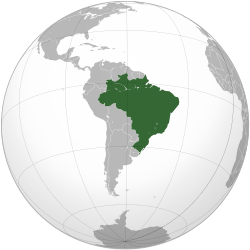
Back Estado Novo (Brasilien) German Nova Ŝtato Esperanto Estado Novo (Brasil) Spanish Estado Novo (Brasil) Basque استادو نوو (برزیل) Persian Estado Novo (Brésil) French Estado Novo (Brasile) Italian Estado Novo (Brazilië) Dutch Estado Novo (Brasil) Portuguese
Republic of the United States of Brazil República dos Estados Unidos do Brasil | |||||||||
|---|---|---|---|---|---|---|---|---|---|
| 1937–1946 | |||||||||
| Motto: "Ordem e Progresso" "Order and Progress" | |||||||||
| Anthem: Hino Nacional Brasileiro (English: "Brazilian National Anthem") | |||||||||
 Brazil's territorial extension | |||||||||
| Capital | Rio de Janeiro | ||||||||
| Government | Authoritarian dictatorship | ||||||||
| President | |||||||||
• 1937–1945 | Getúlio Vargas | ||||||||
• 1945–1946 | José Linhares | ||||||||
| History | |||||||||
| 10 November 1937 | |||||||||
| 22 August 1942 | |||||||||
| 24 October 1945 | |||||||||
| 29 October 1945 | |||||||||
• Inauguration of Eurico Gaspar Dutra | 31 January 1946 | ||||||||
| Currency | Brazilian real (until 1942) Cruzeiro (after 1942) | ||||||||
| |||||||||
The Estado Novo (lit. 'New State'), or Third Brazilian Republic, began on 10 November 1937, and consolidated Getúlio Vargas' power. Vargas had assumed leadership of Brazil following the 1930 revolution that ended the First Republic. The Estado Novo ended politically on 29 October 1945, and officially on 31 January 1946. It was characterized by Brazilian nationalism, centralized power, anti-communism and authoritarianism.
It was part of the period known as the Vargas Era that began with the Second Brazilian Republic.[1] Vargas first took power as provisional president in 1930 following the revolution that ended the First Republic and launched the Second Brazilian Republic. Several ensuing coup attempts failed to depose him, until he granted himself new powers under the Third Brazilian Republic or Estado Novo. In early 1932, the Constitutionalist Revolution led by the Democratic Party of São Paulo, had failed due to a lack of unity within the alliance. As head of the provisional government (1930–1934), Vargas governed by decree until the Constituent Assembly of 1933–1934 adopted a new Brazilian Constitution, alongside a democratically elected legislature.
The Estado Novo period (1937–1945), began when in order to perpetuate his rule, Vargas imposed a new, dictatorial Constitution, and shut down the Legislature to rule Brazil as a dictator.
Getúlio Vargas took power on 10 November 1937, and in a radio broadcast told the nation that his regime intended to "readjust the political organism to the economic needs of the country".[2][page needed]
The 1937 Constitution consolidated his power and allowed him to censor the press and spread propaganda coordinated by the Department of Press and Propaganda (DIP).[3] The National Security Law made it possible to suppress Communism and prevent movements such as the Communist Uprising of 1935. Centralization of power and an import substitution policy helped to fund the industrialization of Brazil, and created institutions to carry it out such as the Companhia Siderúrgica Nacional and the Companhia Vale do Rio Doce.[4]
The Estado Novo is considered a precursor to the military dictatorship in Brazil that began with the 1964 coup, although the two regimes differed on several levels.[5]
- ^ "ESTADO NOVO". FGV CPDOC. Retrieved 4 May 2022.
- ^ Vargas, Getúlio (1941). A nova política do Brasil. Livraria José Olympio – via Google Books.
- ^
Maria Helena Capelato (22 January 2021). "The Estado Novo: Politics and Political Propaganda in Brazil, 1937–1945". Oxford Research Encyclopedia of Latin American History. doi:10.1093/acrefore/9780199366439.013.705. ISBN 978-0-19-936643-9.
- Daryle Williams (2001). Culture Wars in Brazil: The First Vargas Regime, 1930–1945. Duke University Press. p. 83. ISBN 0822327198 – via Google Books. 9780822327196
- ^ "CONSTITUIÇÃO DE 1937". Chamber of Deputies of Brazil. Retrieved 7 March 2021.* Rodrigues, Natália. "Estado Novo". InfoEscola. Retrieved 18 September 2021.
- ^ Azenha, Luiz Carlos (27 March 2014). "Fabio Venturini: No golpe dos empresários, a "mais beneficiada foi a Globo"". VioMundo.
© MMXXIII Rich X Search. We shall prevail. All rights reserved. Rich X Search

